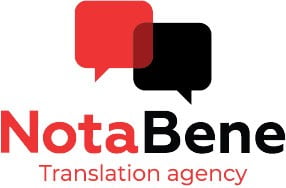Sophisticated QA system for high-quality translation
To deliver a high-quality translation you need to complete a rather intricate procedure. Even the best and most experienced translators can make mistakes, overlook typos, misuse terms, or get bemused by shades of meaning and nuances. In order to rule out even the slightest slips, we employ state-of-the-art quality assurance technologies and apply international standards to our internal processes.
At NotaBene, we ensure excellence in translation by using a sophisticated multi-stage QA system. It requires each translation to be reviewed by an independent editor and then proofread. It also envisages certain workflow phases for QA control.
Order processing flowchart:
- We receive your order
A manager receives an order via a personal account or email, thoroughly analyzes it and
– has the customer approved the ultimate cost and deadline;
– verifies linguistic requirements;
– makes up a glossary and has it approved by the customer, where necessary;
– makes a designated entry for the project in the CRM system,
– identifies the workflow, performance stages, as well as specialists involved.
- We perform the translation
The project is delivered to a translator or team of translators, who perform the translation and send it back to the editor in a staged manner for revision.
- We review/revise/edit the translation
Editing is instrumental in ensuring high-quality translation. An editor reviews and corrects every part of the translation they receive from a translator while making sure that the latter is capable of making changes to the project. The editor is not only responsible for literacy but also sees to it that every term complies with respective glossaries and translation memories (if the project is handled with the use of translation memory databases) and that the entire text and all of its parts are meaningful. Large jobs are normally done by several translators, and the harmonization of terminology and style become a challenging task to be addressed by the editor.
- We proofread the translation
Once the translation has been completed and all of its parts have been reviewed by the editor, the file is proofread in its entirety. The proofreader is responsible for checking all the numeric data — numbers, dates, chapter numbering, as well as the general layout of the text.
- We make up the translation (where required)
Whether regular makeup (charts, tables, figures, etc.) is required, or a customer wishes to have their materials ready for the printing office, the final phase of any project is handled by a DTP specialist (an individual service, where we agree on fees additionally).
- We complete the project
As soon as we are through with the above stages, the manager submits the deliverables to the customer, reports the data to the accounting office for making an invoice, and receives confirmation or comments from the customer.
We make sure the customer’s feedback reaches all parties involved to analyze and include in subsequent projects.
The file is either stored in a special archive on the company’s secure server or deleted in accordance with applicable non-disclosure agreement (NDA) requirements.
QA process: other critical components:
- your order is managed at all stages in the Protemos translation CRM system, which rules out missed deadlines and communication failures, and enables us to control all administrative, financial and other aspects of a project;
- every client benefits from a dedicated manager, who maintains and tracks all information about completed projects in order to meet their customer’s specific requirements;
- technical correspondence, glossaries, as well as customers’ comments are all permanently stored on the company’s server and can be used for future jobs. Therefore, whoever is responsible for your project on your or our side, your style will remain consistent, and your meaning clear;
- high-quality translations are performed exclusively by experts in their respective fields;
- however, to guarantee absolute uniformity, we make use of various CAT tools (software allowing memory storage and update) which have nothing to do with machine translation tools such as Prompt or Google Translate. Their purpose is not to replace a human translator, but only to support their endeavor by ensuring the consistency of vocabulary and making it easier to work on projects with repetitions. Our company has compiled extensive TM databases, each focusing on a specific discipline, mostly technical: oil refining, pneumatic equipment, machine tool accessories, electrical equipment, and many more
A massive project calls for several translators and editors, and each one of them can use the same database. Translation memory software also makes the translation of technical texts much easier — there is no need to work on identical text segments twice: a translator translates this segment only once. The software “remembers” the original translation and then suggests high-quality translation options for recurring parts of future jobs so that a specialist only needs to verify and approve them.
Depending on project requirements, we can carry out a linguistic analysis (LA), perform a linguistic quality assessment (LQA), and conduct a technical audit of the final product (such as the performance of website elements after a new language version is implemented) or focus groups with the target audience for localization projects.
We are passionate about stringent adherence to all these standards. We are somewhat conservative and do not believe in compromise when it comes to quality. We do believe that quality can be either good or bad; there is neither a middle ground nor an excuse for poor quality. But you do not have to take our word for it. Order a translation and see for yourself!








